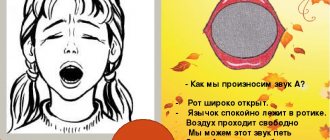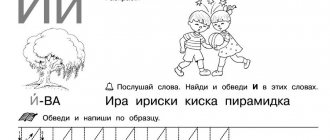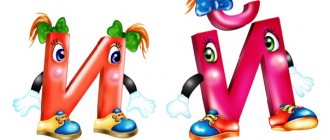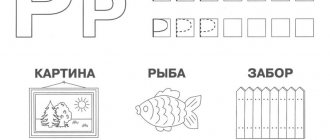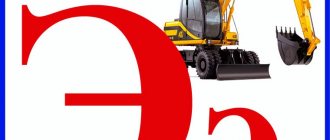Lesson summary with presentation “Sound and letter T” Rezyapova Ksenia Aleksandrovna
author: Rezyapova Ksenia Aleksandrovna
teacher-speech therapist MBDOU "Kindergarten No. 1" Sarov
Lesson notes with presentation “Sound and letter T”
Topic:
“ Sound and the letter T”
Tasks:
- Reinforce the sounds and letters you have learned.
- Learn to highlight the “T” sound at the end of a word.
- Form the concepts of “vowel sound”, “consonant sound”, “letter”.
- Teach sound analysis and synthesis, reading syllables with studied letters.
- Build graphic skills.
- Develop phonemic awareness, auditory and visual attention, memory, thinking, general and fine motor skills.
Equipment:
presentation, cash register letters.
Progress of the lesson
1. Organizational moment.
Ask the children to name the sound by articulation. (“A-U-O-Y-E-I.”)
2. Exercise “What sound?”
- “A”, “O”, “U”, “I”, “E”, “Y” - what sounds are these? Why? (the air stream does not meet an obstacle (teeth, tongue, lips), sung)
- “M”, “P”, “T” - what sounds are these? Why? (the air stream meets an obstacle (teeth, tongue, lips), cannot be sung)
Characteristics of the T sound (consonant, voiceless, can be both hard and soft)
3. Exercise “How many sounds?”
- Listen: “AT” - how many sounds did I make? (2.)
- What's the first sound? What's the second sound? (Also syllables UT, OT, ET, IT, YT.)
4. Exercise “What will happen?”
Look at a couple of pictures of a duck - a bedside table. Invite children to identify the first sounds of words and put them together.
- The first is “U”, the second is “T”. What will happen? Etc. to form the syllables AT, OT, ET, IT.
5. Exercise “Repeat the phrase and choose a picture.”
Talk to the children in pure language (in chorus and individually) and ask them to choose a suitable picture.
- At-at-at - we eat salad.
- From-from-from - we drank compote.
- It-it-it - a whale is swimming in the sea.
- This-this-this - the lights were turned on in the house.
6. Exercise “Where is the sound “T?”
Using the pictures from the previous exercise, determine the position of the sound “T” in the words: salad, compote, whale, light.
7. Game “Repeat, don’t make a mistake.”
Invite the children to repeat the line of words, select the corresponding pictures and put them in the given order:
- Cat - whale - hippopotamus.
- Salad - robe - fireworks.
- Light - ticket - bow.
Ask questions:
— Tell me, where in the word “cat” (“whale”, “hippopotamus”, etc.) is the “T” sound heard?
- Physical education minute.
| From-from-from - the hippopotamus is walking. | Children walk slowly, waddle. |
| Oot-out-out - everyone swims together. | Imitates the movements of swimmers. |
| Ut-ut-ut - festive fireworks. | They imitate fireworks in the sky. |
| At-at-at - we're going to the parade. | Marching. |
9. Game "Well".
On a magnetic board, place cards with the letters A, U, O, I, E, Y in a column. Attach the card with the letter T to the picture with the image of a bucket. Lower the “bucket” into the “well” to the right of the letters. Read the received syllables.
10.Working with cash registers.
Invite the children to spell out the syllables AT, UT, IT, YT, ET, OT and read them.
11.Work in a notebook of speech therapy tasks.
Ask the children to type one syllable of each pattern.
Lesson summary with presentation “Sound and letter T” Rezyapova Ksenia Aleksandrovna
Target.Clarify the articulation of sounds [t—t'], practice their differentiation; consolidate the ability to determine the sequence of sounds in monosyllabic words; expand children's vocabulary with antonym words; work on the generalized meaning of words; familiarize children with the image of the letter Tt; consolidate images of letters; prepare your hand for writing.
Equipment.
Mirrors, a diagram for analyzing articulatory sounds, a set of pictures, sound houses, panels of letters, sheets of paper with images of double lines, pencils; scissors and cut out letters according to the number of children.
Progress of the lesson
I. - Today we will meet two boys. Their names are Tim and Tom. Let's determine how many syllables and what sounds are in their names.
Tim - O. The first sound is [t'], the second is [i], vowel, the third is [m], consonant, hard.
Tom - Oh, the first sound is [t], the second is [o], vowel, the third is [m], consonant, hard.
The teacher asks to repeat the first sounds in the boys' names ([t1] and [t]).
“Today we will get acquainted with these sounds.”
II. 1 . Articulation of sounds.
Analysis according to the scheme.
The lips are slightly open, the teeth are open, the tip of the tongue when pronouncing the sound [t] closes with the upper teeth, when pronouncing the sound [t'] the tip of the tongue is lowered and rests on the lower teeth, the vocal cords do not vibrate.
Characteristics of sounds.
The sounds [t-t'] are consonants, there are soft and hard.
III. 1. Differentiation of sounds [t—t'] in the game “Replace the sound.”
Tim liked words with a soft sound [t'], and Tom liked words with a hard sound [t]. As soon as one pronounces a word with a hard sound [t], the other immediately replaces it with a soft [t']. And vice versa. For example: brother
-
take.
Which word did Tim say and which did Tom say? Why do you think so?
Tom said the pole,
and Tim - ...
(six).
Tim said tough
and Tom - ...
(gesture).
The teacher draws attention to the fact that as the sound changes, the meaning of the words changes. Asks to explain the meaning of words and make sentences with them.
Game “It was and became” for the use of antonym words.
— When Tom and Tim were little, their parents planted a poplar tree in the yard. The boys loved this tree very much. They were growing. The poplar also grew. Tim and Tom often remembered what he was
poplar, and were proud, looking at him, of what he had become.
I will talk about the poplar when it was a seedling. And you will choose a word with the opposite meaning and say what he has become now.
The poplar was thin
became... (fat);
was low,
became...
(tall);
was
young,
became... (old).
There were few branches ,
there were ... (many).
The branches were short,
they became ...
(long).
The bark was
smooth,
but became
... (rough).
The leaves were
small,
became
... (large),
were
wet,
became ... (dry), were
light,
became ...
(dark).
4. Work on the generalized meaning of words (transport).
— Tom and Tim lived in a big city. They knew all the city transport. And the word transport
Tom especially liked it. Why? (What are the first and last sounds in this word?)
Children, what city transport do you know? (Tram, trolleybus, taxi, bus, metro)
The teacher asks to determine the place of the sound [t] in all words.
- Which of the boys liked all these words? (To that. In all words the sound [t] is hard)
IV. 1. Introducing the letter Tt.
The sounds [t—t'] in the letter are indicated by the letter Tt, who lives at the address: second floor (second row from the bottom), apartment No. 4 (fourth cell from the left).
2. Analytical and synthetic activity (using scissors and a letter constructor).
V. Exercise “Tram” to prepare your hand for writing. Practice drawing lines (from left to right), trying not to take your hands off the sheet and not to go beyond the intended contour.
Double winding lines (tram rails) are depicted across the entire area of the sheet. The lines are continuous.
— These lines are tram rails. You will walk the entire route by drawing a pencil line inside the rails. And you should not go beyond the contours of the lines.
The tram must quickly transport passengers from the city (symbol: house) to the park (symbol: Christmas tree). Therefore, your trams are allowed not to make stops. But if your arm gets tired, you will stop and mark it with a circle.
Note.
Analysis of the performance of this task will help educators establish individual differences in the muscular endurance of children’s arms. In accordance with the results obtained, teachers plan individual work with children.

